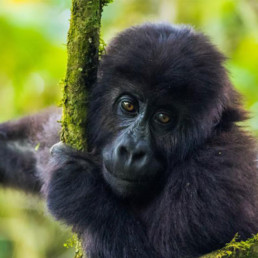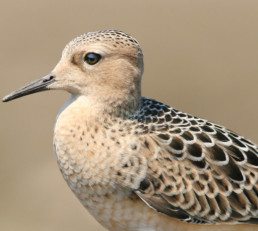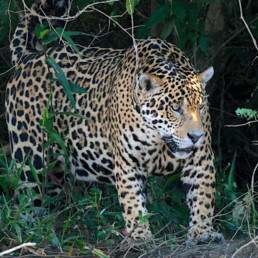Why care about species?
Protecting species is essential for diverse reasons, reflecting the varied values people hold. Some emphasize the intrinsic value of biodiversity, recognizing each species as part of Earth’s natural heritage. Others highlight the vital ecosystem services, such as pollination and climate regulation, that impact human well-being. The ethical responsibility to prevent extinction due to human activities is a shared concern, and conservation efforts contribute to ecological balance. The aesthetic and recreational enjoyment of nature also motivates many, underlining the importance of preserving species for future generations. Ultimately, safeguarding species contributes to the resilience and sustainability of ecosystems, benefiting both wildlife and human societies.
Time to act
Some of the threatened species our partners are working to protect :
We find ourselves in the midst of a mass extinction crisis, where numerous species are at risk of disappearing forever due to human-induced factors. It is a critical moment that demands urgent action to halt and reverse the loss of biodiversity. The choices we make today will have a profound impact on the biological heritage we leave for future generations. Addressing the root causes of extinction, such as habitat destruction, pollution, and climate change, is essential to mitigate the ongoing crisis. By taking decisive steps now, we can not only save countless species but also contribute to the preservation of ecosystems and the overall health of our planet. This collective effort is crucial to ensure a sustainable and vibrant natural world for the well-being of both present and future generations.
Hooded grebe
Podiceps gallardoi
Critically endangered
It is surprising that this showy grebe with its equally showy courtship dances was unknown to science until 1974, but its very limited range in the cold remote lakes of windswept Patagonia might account for that. Its courtship dance is one of the most spectacular of all waterbirds with moves nearly identical to the Argentine tango. Since its discovery its population has plummeted to only about 1,000 individuals, due to predation by non-native American minks and Rainbow Trout. A gamechanger now steadying the population is the deployment of artificial floating nest platforms on all of the lakes their small nesting colonies are found. Grebe Guardians are present at all known nests 24/7. ICF supports the field work of Aves Argentinas’s Grebe Guardians to deploy nest platforms and remove invasive predators.
African Forest Elephant
Loxodonta cyclotis
Critically endangered
The African Forest Elephant is the smallest of the three living elephant species, and is native to the humid tropical forests in West Africa and the Congo Basin. The species is listed as Critically Endangered on the IUCN Red List.
Eastern Lowland Gorilla
Gorilla beringei graueri
Critically endangered
Grauer’s Gorillas are found exclusively in the mountainous forests of eastern Democratic Republic of the Congo. The population of Grauer’s gorilla has rapidly declined from an estimated 16,900 individuals in the mid-1990s to fewer than 3,800 individuals today.
Giant Otter
Pteronura brasiliensis
endangered
Giant Otters are up to 1.7 m long, with a long well-muscled tail. It is well adapted to life in the water having short, extremely dense fur that keeps water from penetrating to the skin. Multiple ICF projects across South America contribute to the preservation of the Giant Otter.
Irrawaddy Dolphin
Orcaella brevirostris
Critically endangered
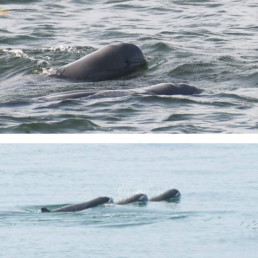
The Irrawaddy dolphin’s name come from the Irrawaddy River, the largest in Myanmar. This gray, medium-sized porpoise has a blunt face resembling a Beluga whale but is more closely related to an Orca. The Irrawaddy hunt for fish in groups and can jet water up to 5 feet to herd fish. They are known to respond to fishermen when called by tapping and have been trained to herd fish into their nets for them. Because they live close to shore they have been more impacted by people and are particularly susceptible to drowning in gill nets. ICF support the work of Marine Conservation Cambodia to construct and deploy cement anti-trawling blocks to dissuade the use of nets in protected areas. The blocks not only asst the restoration of sea grass beds, but also serve as artificial reef.
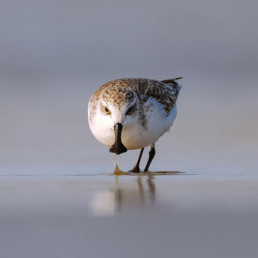
Spoon-billed Sandpiper
Calidris pygmaea
Critically endangered
It might be the spoon-shaped bill of the Spoon-billed Sandpiper that not only serves as its unique tool to acquire food but also as the means that saves it from extinction by appealing to the world as uniquely adorable. Although it is the world’s most endangered migratory shorebird with only 300 individuals, there are people working hard to protect it in nearly all of the 15 countries it travels to annually. A gamechanger, saving this shorebird, is the enforcement actions removing miles of illegal bird nets on the mudflats that “spoonies” and other endangered shorebirds need in China, Bangladesh, Myanmar, and Thailand. ICF supports the coordinated efforts of NGOs and Village Community Associations in 4 countries to promote the protection of endangered shorebirds and the on-the-ground removal and confiscation of illegal bird nets.
Vaquita Porpoise
Phocoena sinus
Critically endangered
The Vaquita is a shy member of the porpoise family and the world’s smallest cetacean (4 to 5 ft. in length). They also have the smallest range of any whale species and are now confined to the northern Upper Gulf of California. They are sexually mature starting between 3 and 5 years of age, and they can give birth to one calf every other year. Females normally give birth between February and April to a 2.5 ft long calf weighing about 16 lbs.
Maleo
Marcrocephalon maleo
Critically endangered
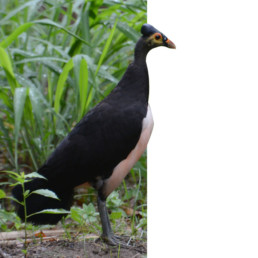
The Maleo is a large, black chicken-like bird and as a species is the only member of its genus, within the Megapode family (“large feet”). It is endemic only to the island of Sulawesi, Indonesia. By all accounts is it not only weird in its appearance but especially unique in its breeding behavior. Although it lives in the rain forest, Maleos gather at breeding sites with hot volcanic sands or hot sandy beaches to scratch holes up to a meter deep, a lay one enormous egg each, then bury the egg, to incubate in the hot sand. Maleos guard their nests from monitor lizards that try to dig up the eggs, and successful eggs hatch a chicken underground 90 days later. The chick claws its way to the surface fully feathered and ready for flight school. When capable of good flight they return to their primary habitat in the rain forest.
Field partner Alliance for Tompotika Conservation (ALTO) monitors and protects the largest Maleo breeding colonies in existence, as well as other endangered forest species of bats, tarsiers, and sea turtles.
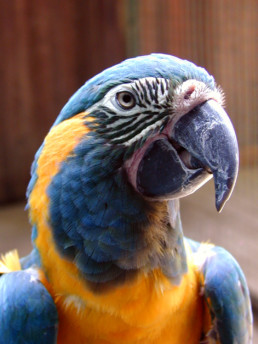
Blue-Throated Macaw
Ara glaucogularis
Critically endangered
The Critically Endangered Blue-throated Macaw, with a total wild population of fewer than 300 individuals, is found only in the Beni Savanna of Bolivia, where Barba Azul Reserve constitutes key non-breeding habitat, with counts of up to 155 birds (2017). The reserve also protects the Beni Savanna ecosystem in a natural state, protecting it from fires and overgrazing. Our field partner Asociación Armonía is dedicated to implementing effective conservation strategies, coordinating with local communities to protect the Bolivia’s wildlife and habitats in programs throughout the country.
Rüppell's Griffon
Gyps rueppelli
Critically endangered
Rüppell’s Griffon is thought to be the world’s highest-flying bird, with evidence of birds soaring at 37,000 feet, thus at eye level with passengers on commercial aircraft. It’s also a very large vulture with a wingspan of up to 8.5 ft. This species is not very migratory and is found nesting on cliffs across Sub-Saharan Africa where it feeds on carrion in the regions, mountains, woodlands, and grasslands. They are monogamous and the young are fed until they are one year old. The primary threat is the death from poisons used in carcasses that target mammalian predators such as hyenas and lions. ICF is supporting Masaai community volunteers who guard nesting cliffs in the South Great Rift Valley.
Magellanic Plover
Pluvianellus socialis
Vulnerable
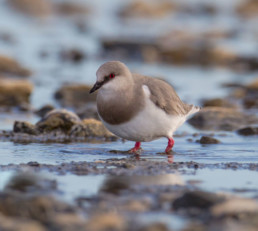
The Magellanic Plover looks like a cross between a shorebird and a dove, and in fact is a unique species of shorebird with no other relatives within its entire genetic family Pluvianellidae. It is also a very rare bird confined to southern South America where its population is much smaller than originally believed. Although it nests along the edges of lagoons of the most remote and barren landscapes of Patagonia, it is threatened by sheep that may trample their nests. ICF supports the field work of Aves Argentinas to locate and protect this specie’s nests using predator fencing.
Buff-Breasted Sandpiper
Calidris subruficollis
Near Threatened
The Buff-breasted Sandpiper (Calidris subruficollis) is a light buff-colored, diminutive shorebird that is unsuspicious of an approaching human. This may contribute to its steep decline over the past century, as well as the loss of the short grass habitats it favors. It is one of the longest distance migratory birds in North America, with one individual known to have flown 41,000 km round trip between its high Arctic nest site and its wintering site in southern South America.

The Red Knot is one of the world’s long-distance avian travelers, with annual roundtrip flights of up to 18,000 miles between its Arctic tundra nesting area and its southern wintering area in Tierra del Fuego. One individual knot, dubbed “Moon Bird” was marked with an orange leg band, number B95. It was known to make this journey every year for at least 22 years and thus traveled the same distance to the moon and back. To make this incredible journey most Red Knots rely on the healthy abundance of horseshoe crab eggs to refuel, particularly at the most important site in Delaware Bay.
ICF supports our field partners in Argentina to protect important shorebird refueling sites from human disturbance, ATVs, and dogs.
The Pacific Red Knot breeds on the tundra of Alaska and Canada and half of its population winters in northwest Mexico. Every spring this threatened subspecies takes advantage of one of nature’s greatest spectacles—the spawning of Gulf Grunion Sardines. Similar to the northbound Red Knots of the Atlantic Coast, which feed on the eggs of Horseshoe Crabs, the Pacific Red Knot fattens up on grunion eggs to make the long flight back to the Arctic Tundra.
ICF supports the field work of the “Grunion Queens” and Pronatura Noroeste to protect miles of beach with spawning grunions and thousands of Red Knots and other shorebirds at sites in NW Mexico.
Hyacinth Macaw
Anodorhynchus hyacinthinus
Vulnerable
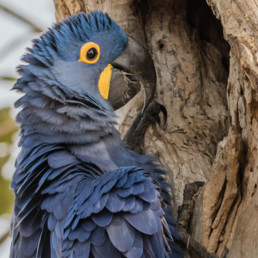
The Hyacinth Macaw is the world’s largest macaw species, and it is made even more magnificent by its deep cobalt blue plumage, large black beak and striking yellow facial highlights. Like many macaw species, it has disappeared from much of its range at the hands of the illegal pet trade.
Jaguar
Panthera onca
Near Threatened
The Buff-breasted Sandpiper (Calidris subruficollis) is a light buff-colored, diminutive shorebird that is unsuspicious of an approaching human. This may contribute to its steep decline over the past century, as well as the loss of the short grass habitats it favors. It is one of the longest distance migratory birds in North America, with one individual known to have flown 41,000 km round trip between its high Arctic nest site and its wintering site in southern South America.
Spectacled Bear
Tremarctos ornatus
Vulnerable
Known as Ukuku in Quechua, it is the only species of bear native to South America, occurring in the Andes Mountains, from western Venezuela to southern Bolivia, occupying habitats ranging from desert-scrub to forests and high-altitude grasslands.
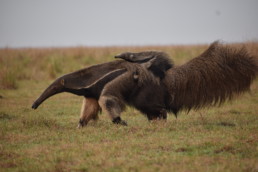
Giant Anteater
Myrmecophaga tridactyla
Vulnerable
The giant anteater is not only captivating but, above all, it plays a crucial role in maintaining the health and balance of ecosystems. Recognized as an insectivorous marvel, this species helps control ant and termite populations, contributing to pest regulation and the overall ecological equilibrium. Given its extensive distribution range in South America, multiple partners supported by ICF are actively working to preserve its habitat.
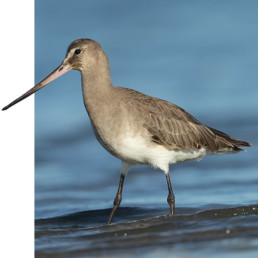
Hudsonian Godwit
Limosa haemastica
Steep Declines
The Hudsonian Godwit is another long-distance flier from its Arctic boreal nest sites south to southern South America where it winters, but what is remarkable about this species is that it is capable of non-stop flights up to 6,000 miles without food, water, or rest. It is one of the largest migratory shorebirds in the world and congregates in flocks of the remaining thousands at only a few sites in Chile and Argentina. It is highly vulnerable to hunting, loose dogs, and human disturbance.
ICF supports our Chilean field partner Fundación Conservación Marina expand shorebird reserves, establish bird ecotourism, and protect the habitats of thousands of Hudsonian Godwits (40% of the Pacific Coast population).


